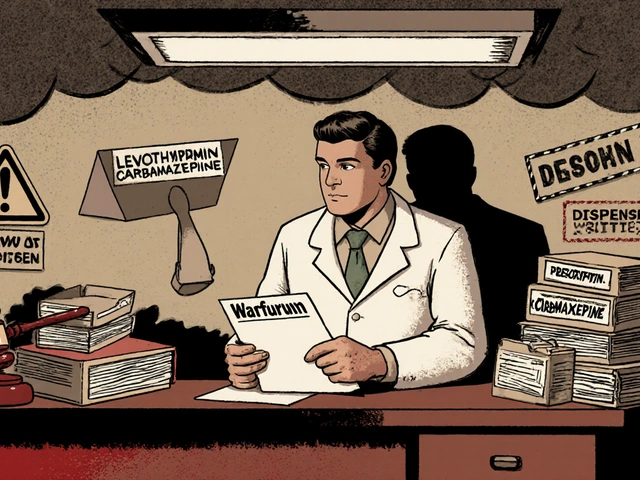The Safety of Nitrofurantoin During Pregnancy
Understanding Nitrofurantoin and Its Uses
Nitrofurantoin is a commonly prescribed antibiotic that is used to treat and prevent urinary tract infections (UTIs). It works by targeting the bacteria responsible for causing UTIs and inhibiting their growth. This antibiotic is effective against a variety of bacterial strains, making it a popular choice for the treatment of UTIs in both pregnant and non-pregnant individuals. However, as with any medication, it is important to consider the potential risks and benefits when using nitrofurantoin during pregnancy.
In this article, we will explore the safety of nitrofurantoin during pregnancy, examining the potential side effects and risks associated with its use. We will also discuss the instances in which nitrofurantoin may be prescribed during pregnancy and provide advice on how to take this medication safely. By the end of this article, you should have a better understanding of the safety of nitrofurantoin during pregnancy and be able to make an informed decision about its use.
Is Nitrofurantoin Safe During Pregnancy?
Overall, nitrofurantoin is considered to be a safe and effective treatment option for UTIs during pregnancy. Many studies have been conducted to assess the safety of this antibiotic in pregnant women, and the results have generally been reassuring. The majority of these studies have not found any significant increase in the risk of birth defects, miscarriage, or other adverse pregnancy outcomes when nitrofurantoin is used during pregnancy.
However, it is important to note that some studies have suggested a small increased risk of certain birth defects, such as heart defects and oral clefts, when nitrofurantoin is used during the first trimester of pregnancy. While these findings are concerning, it is important to remember that the overall risk of these birth defects remains low even if there is a slight increase in risk associated with nitrofurantoin use. Additionally, the benefits of treating a UTI during pregnancy often outweigh the potential risks, as untreated UTIs can lead to more serious complications for both the mother and the baby.
When is Nitrofurantoin Prescribed During Pregnancy?
Nitrofurantoin is typically prescribed during pregnancy when a woman has a confirmed UTI or when there is a high suspicion of a UTI based on her symptoms. UTIs are more common during pregnancy due to the hormonal changes and increased pressure on the urinary tract. It is important to treat UTIs during pregnancy, as they can lead to more serious complications such as kidney infections, premature labor, and low birth weight if left untreated.
While there are other antibiotics available for the treatment of UTIs, nitrofurantoin is often chosen due to its effectiveness against the most common bacteria responsible for these infections. However, your healthcare provider will consider your individual circumstances and any potential risks before prescribing nitrofurantoin during pregnancy.
How to Take Nitrofurantoin Safely During Pregnancy
If you are prescribed nitrofurantoin during pregnancy, it is important to follow your healthcare provider's instructions carefully to ensure the medication is taken safely and effectively. Some general guidelines for taking nitrofurantoin during pregnancy include:
- Take the medication exactly as prescribed by your healthcare provider. Do not skip doses or stop taking the medication without consulting your provider, as this can lead to an incomplete treatment and increase the risk of complications.
- Take nitrofurantoin with food or milk to help reduce the risk of stomach upset.
- Drink plenty of water while taking nitrofurantoin to help flush the bacteria from your urinary tract and to prevent dehydration.
- Inform your healthcare provider if you experience any side effects or if your symptoms do not improve within a few days of starting treatment.
Alternatives to Nitrofurantoin During Pregnancy
If you are concerned about the safety of nitrofurantoin during pregnancy or if you are unable to take this medication due to allergies or other contraindications, there are alternative antibiotics available for the treatment of UTIs. Some common alternatives include amoxicillin, cephalexin, and trimethoprim-sulfamethoxazole (TMP-SMX). Your healthcare provider will consider your individual circumstances and the potential risks and benefits of each medication before prescribing an alternative antibiotic during pregnancy.
In conclusion, nitrofurantoin is generally considered to be a safe and effective treatment option for UTIs during pregnancy. However, it is important to weigh the potential risks and benefits of this medication with your healthcare provider, especially if you are in your first trimester. By following your provider's instructions and taking the medication as prescribed, you can help ensure a healthy and uncomplicated pregnancy.






19 Comments
Javier Muniz
April 29 2023Hey there! Nitrofurantoin is usually a solid option for treating UTIs during pregnancy, especially when you stick to the dosing schedule and take it with food. It helps clear the infection fast and reduces the risk of kidney complications. Just make sure to stay hydrated and keep your doctor in the loop if anything feels off.
Stay healthy!
Sarah Fleming
May 3 2023What the mainstream medicine isn’t telling you is that nitrofurantoin is a covert tool in a grander scheme to control maternal health outcomes! The “studies” that say it’s safe are riddled with hidden biases, and the subtle heart defect signals in the first trimester are a red flag waved by hidden agencies. Wake up, people – don’t let them silently poison the next generation under the guise of “clinical safety.”
Debra Johnson
May 8 2023It is a moral imperative for healthcare providers to base their prescriptions on unequivocal evidence rather than on convenience or cost. The literature on nitrofurantoin, while largely reassuring, does contain isolated reports of congenital heart anomalies that cannot be dismissed outright. Each pregnant patient deserves a thorough discussion of these findings, no matter how statistically small the risk may appear. Ignoring such data borders on negligence, a lapse that contravenes the Hippocratic oath. Moreover, the potential for renal toxicity in the fetus, albeit rare, must be weighed against the benefits of eradicating the infection. Physicians have an ethical duty to disclose all known risks, however minute. Informed consent is not a mere formality; it is a cornerstone of patient autonomy. When a drug is administered during the critical first trimester, the stakes are amplified exponentially. The fragile window of organogenesis demands the utmost caution. Women should feel empowered to ask for alternative antibiotics if they harbor any doubt. This empowerment aligns with the broader principle of shared decision‑making in obstetric care. The medical community must also remain vigilant for emerging post‑marketing surveillance data. Any sign of increased malformation rates should trigger immediate reevaluation of treatment guidelines. The safety of mother and child is a shared responsibility, not a unilateral judgment. Ultimately, preserving trust in the healthcare system hinges on transparency, rigorous scrutiny, and unwavering moral resolve.
Andrew Wilson
May 13 2023Yo, i totally get that doc's say it's fine but if ur feeling weird just holla at ur midwife. No point takin' sumthin' that might mess ur belly up. Plus, we all know those pharma bros push stuff for profit. Stay chill and listen to ur gut.
Kristin Violette
May 17 2023From an evidence‑based pharmacokinetic perspective, nitrofurantoin’s renal excretion profile lends itself well to pregnant physiology, provided glomerular filtration rates remain within normative parameters. However, one must also consider the teratogenic potential quantified by the teratogenic index (TI) during organogenesis. Could a stratified risk‑benefit algorithm be integrated into prenatal care pathways to optimize therapeutic outcomes? Collaborative interdisciplinary frameworks could facilitate such nuanced decision‑making, ensuring both maternal and fetal homeostasis are maintained.
Theo Asase
May 22 2023Let’s not forget that the very recommendation of nitrofurantoin stems from a centralized health agenda that prioritizes pharmaceutical profits over American motherhood! The “research” praising its safety is nothing but a veil draped over corporate interests, aiming to keep our women dependent on big‑drug solutions. Real patriots must demand transparent, home‑grown alternatives that truly safeguard our next generation.
Joey Yap
May 27 2023I hear the concerns about first‑trimester exposure and it’s understandable to feel uneasy. Balancing the mother’s wellbeing with the baby’s developing systems is a delicate act, and every decision carries weight. Compassionate listening and shared deliberation can illuminate the path that feels right for each individual family.
Lisa Franceschi
May 31 2023It is advisable to consult a qualified obstetrician for a thorough evaluation of the potential risks and benefits associated with nitrofurantoin therapy during gestation. A measured approach, grounded in current clinical guidelines, will ensure optimal maternal‑fetal health outcomes.
Diane Larson
June 5 2023Hey everyone! If you’re looking for alternatives, amoxicillin and cephalexin are both solid options that have robust safety data in pregnancy. Talk to your provider about allergy history and the specific bacterial strain, and they can tailor the treatment accordingly. Stay healthy!
Michael Kusold
June 10 2023yeah nitrofurantoin works but i heard some ppl get weird lung stuff. just keep an eye on it.
Jeremy Lysinger
June 14 2023Take it with food and plenty of water.
Nelson De Pena
June 19 2023Ensuring adequate hydration while on nitrofurantoin not only minimizes gastrointestinal discomfort but also facilitates renal clearance of the drug, thereby enhancing its therapeutic efficacy.
Wilson Roberto
June 23 2023Across cultures, the stewardship of antimicrobial agents reflects a shared responsibility to preserve both individual health and communal resilience. By adhering to prescribed regimens, we honor this collective ethos without resorting to unnecessary digital symbols.
Narasimha Murthy
June 28 2023While the prevailing consensus endorses nitrofurantoin’s safety profile, a meticulous re‑examination of the primary data reveals methodological shortcomings that merit skepticism. One must therefore approach the prevailing narrative with measured doubt.
Samantha Vondrum
July 3 2023Dear colleagues, the integration of patient‑centered communication, complete with appropriate emotive cues 😊, can substantially improve adherence to nitrofurantoin therapy during pregnancy. Let us embrace both rigor and empathy in our practice.
Kelvin Egbuzie
July 7 2023Sure, just trust the “experts” who love pushing nitrofurantoin like it’s candy 🍭-because nothing says “good health” like a drug with a hidden track record of rare defects. 🙄
Katherine Collins
July 12 2023i guess nitrofurantoin is ok? idk tho 😂
Taylor Nation
July 17 2023Let’s agree that a balanced discussion, incorporating both clinical evidence and patient preferences, is the best way forward. I’m happy to support anyone who wants to dive deeper into the data.
Nathan S. Han
July 21 2023In the grand tapestry of prenatal care, nitrofurantoin emerges as a vital thread, weaving protection against infection while demanding our vigilant stewardship. Let us march forward with confidence, armed by science and compassion, to safeguard both mother and child.